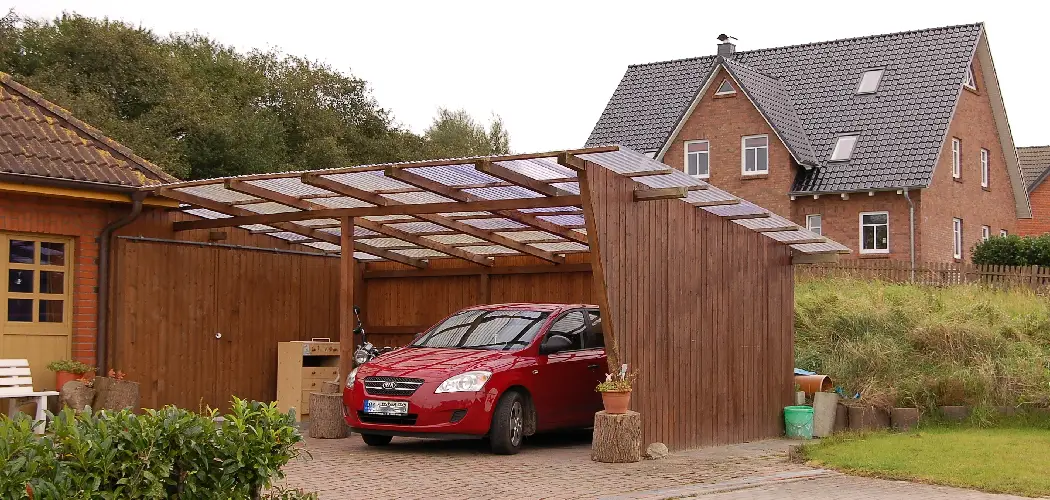Enclosing a carport can provide numerous benefits for homeowners. One of the main reasons why you might consider enclosing your carport is to protect your vehicle from the elements. This can help prevent damage from rain, snow, and sunlight, which can all cause wear and tear on your car’s exterior.

The main advantage of enclosing a carport is to expand your living space. If you have limited indoor space but want to create an additional room for storage, hobbies, or even as a guest room, enclosing your carport is a cost-effective solution. It also adds value to your home by increasing the total square footage. In this blog post, You will learn in detail how to enclose a carport ideas.
Step-by-step Instructions for How to Enclose a Carport Ideas
Step 1: Inspect the Current Structure
Before starting the process of enclosing your carport, it is important to take a close look at the current structure and evaluate its condition. Check for any damages or weak spots that must be addressed before proceeding with the enclosure.
Step 2: Obtain Necessary Permits
Depending on your location, you may be required to obtain permits before enclosing your carport. Check with your local building authority to ensure you have all the necessary permits in place. There are various ways to enclose a carport, from fully enclosing it with walls and windows to simply adding screens or curtains. Consider the function of the space and your budget when deciding on a design.
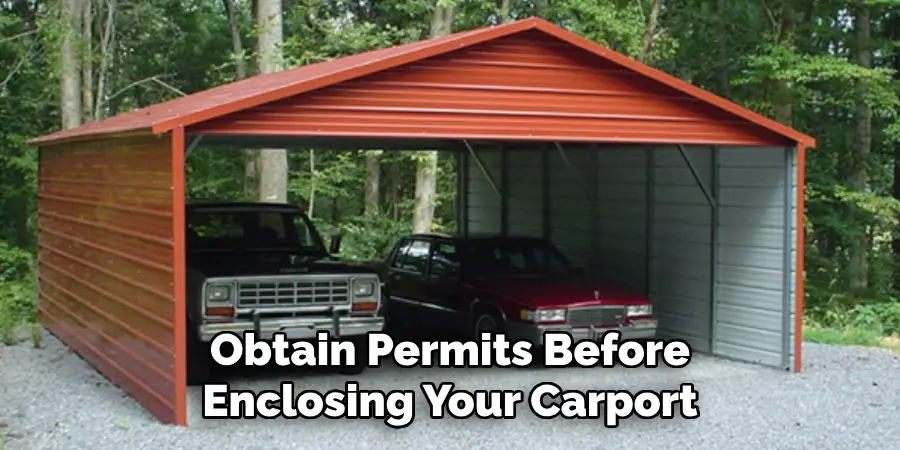
Step 3: Gather Materials
Once you have decided on a design, gather all the necessary materials. This may include lumber for framing, drywall or paneling for walls, insulation, windows or screens, and any additional hardware. Before starting the enclosure process, make sure to clean and clear out your carport. Remove any vehicles or items in the way and thoroughly clean the space.
Step 4: Frame the Walls
Using the lumber and tools, frame the walls of your carport according to your chosen design. Make sure to leave enough space for windows or screens if you plan on having them. Consider adding insulation between the walls to make your enclosed carport more energy-efficient. This will help regulate the temperature inside and reduce noise.
Step 5: Add Windows or Screens
If your chosen design includes windows, install them on the framed walls. If you opt for screens, add them to the openings of your carport. This will allow for natural light and ventilation. Cover the framed walls with drywall or paneling to give your enclosed carport a finished look. You can also choose to paint the walls to match the rest of your home.
Step 6: Add Finishing Touches
To truly make your enclosed carport feel like an extension of your home, add some finishing touches, such as flooring, lighting, and furniture. This will create a functional and inviting space.
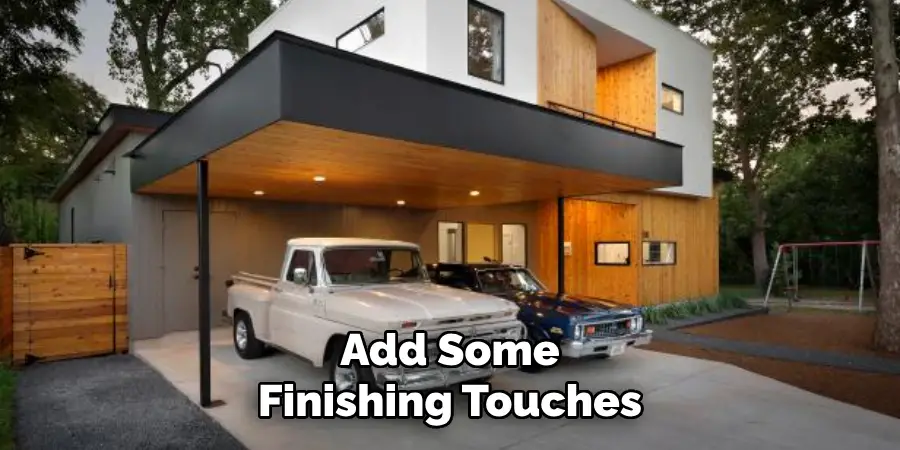
By following these step-by-step instructions, you can successfully enclose your carport and create a versatile and valuable addition to your home. But before you begin the process, consider consulting with a professional to ensure safety and proper installation. With the right design and materials, your enclosed carport can become integral to your living space.
Safety Tips for How to Enclose a Carport Ideas
- Only try to enclose a carport with proper knowledge and skills. Before attempting any DIY projects, it is important to hire professionals or seek guidance from experts.
- When enclosing a carport, make sure to check local building codes and regulations. This will ensure that your project is up to standard and safe for you and your family.
- Before starting the project, inspect the carport for any damages or structural issues. Repair or reinforce these areas before enclosing to ensure the safety and stability of the structure.
- It is important to use appropriate materials when enclosing a carport. This includes high-quality insulation, weather-resistant walls, and proper ventilation to prevent mold and mildew growth.
- Plan accordingly for electrical outlets and lighting fixtures in your enclosed carport. For safety purposes, it is crucial to have a licensed electrician install them.
- When enclosing a carport, it is important to consider your home’s overall design and aesthetics. Choose materials and colors that complement the existing structure for a cohesive look.
- Regular maintenance is key to ensuring the safety of an enclosed carport. Make sure to inspect the walls, roof, and electrical systems on a regular basis and address any issues immediately.

By following these safety tips, you can successfully enclose a carport while ensuring the safety of your family and property. Remember to always prioritize safety over aesthetics when making any changes to your home.
Disadvantages of Enclosing a Carport Ideas
- Enclosing a carport can be costly, especially if you hire professionals to do the job. Budgeting accordingly and considering all expenses involved before starting the project is important.
- Enclosing a carport can also be time-consuming. Depending on the complexity of the project, it may take several days or even weeks to complete.
- If not properly insulated, an enclosed carport can cause condensation to build up, leading to mold and mildew growth. This can be hazardous to your family’s health and may require frequent maintenance.
- Enclosing a carport reduces natural light and ventilation in the area. This can make it feel stuffy and uncomfortable, especially during hot summer days.
- In some areas, enclosing a carport may require obtaining permits and passing inspections, which can add to the project’s time and cost.
- Unlike other home improvement projects, an enclosed carport may not add value to your home. In some cases, it may even decrease its value.
- Depending on how the carport is enclosed, access to certain areas of your property may be limited. This can be inconvenient for storage or for using the carport as a functional outdoor space.
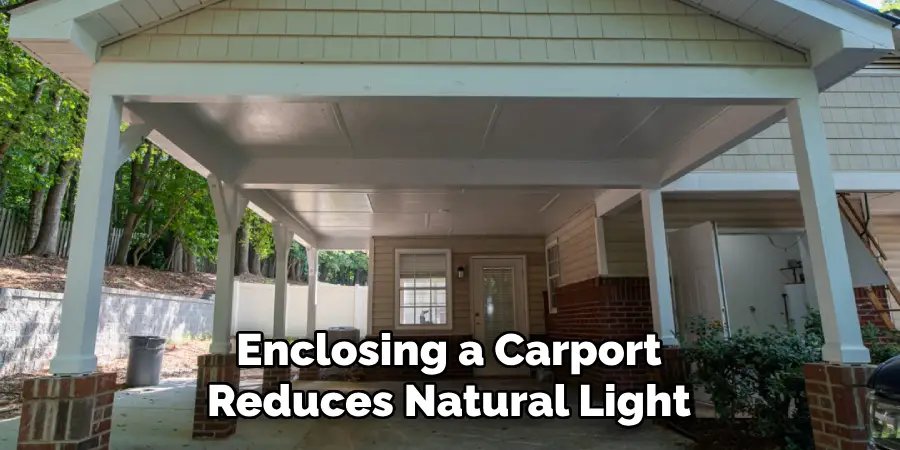
Despite these disadvantages, with proper planning and execution, enclosing a carport can still benefit many homeowners. Consider all factors carefully before deciding to enclose your carport.
Some Creative Ideas for Enclosing a Carport
- Build a greenhouse on top of your carport to protect your plants from harsh weather conditions.
- Add lattice panels and climbing plants to create a beautiful, natural enclosure for your carport.
- Install sliding glass doors or windows to enclose your carport and turn it into an additional living space, such as a home office or workout area.
- Use decorative metal screens or panels to add a unique and modern touch to your carport enclosure.
- Build a pergola above your carport and hang curtains or drapes for a stylish and functional enclosure.
- Use reclaimed wood or pallets to create a rustic and eco-friendly carport enclosure.
- Install a retractable awning or canopy over your carport to provide shade and protection from the elements while still allowing for an open feel.
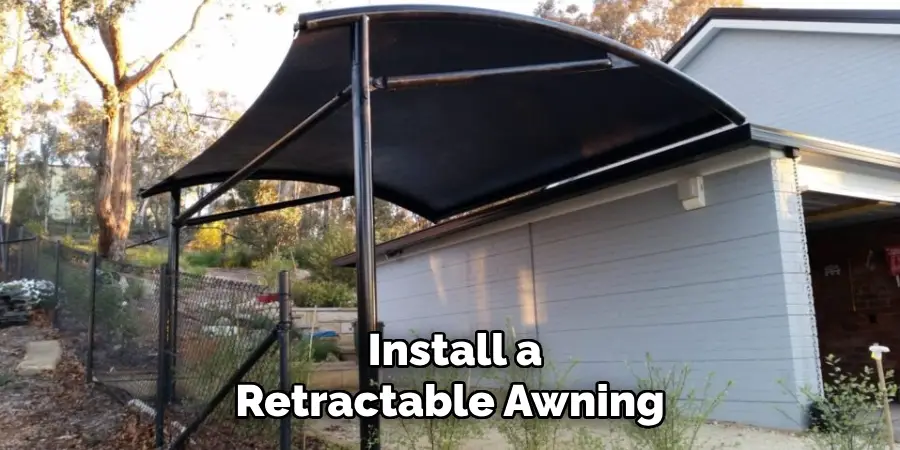
By using these creative ideas, you can add value, functionality, and style to your carport while also protecting your vehicle from the elements. Not only will an enclosed carport provide shelter for your car, but it can also serve as a multi-purpose space for various activities.
Maintenance Tasks After Enclosing a Carport Ideas
- Clean the Interior and Exterior of Your Enclosed Carport Regularly – Dust and debris can quickly accumulate in an enclosed space, making it look dirty and uninviting. Regular cleaning will keep your enclosed carport looking fresh and help prevent potential damage to its surfaces.
- Check for Any Signs of Water or Moisture Buildup – Enclosed carports are prone to moisture buildup, especially if there is poor ventilation or a lack of proper drainage. Look for any signs of water damage, such as mold or mildew growth, and address them immediately before they cause further damage.
- Inspect the Structure for Wear and Tear—Over time, the structural components of an enclosed carport can weaken due to exposure to the elements. Make sure to regularly inspect the carport’s roof, walls, and supports for any signs of wear and tear, such as cracks or rust. If you notice any issues, address them promptly before they become bigger problems.
- Maintain the Door and Windows – The door and windows of an enclosed carport are crucial components that can easily become damaged if not properly maintained. Regularly check for any signs of wear and tear, such as broken seals or damaged frames, and address them immediately to ensure proper functionality.
- Keep the Surrounding Area Clean – A cluttered and dirty surrounding area can make your enclosed carport look unappealing and attract pests and rodents. Make sure to keep the area around your carport clean and free of any debris or standing water.
- Lubricate Moving Parts – If your enclosed carport has any moving parts, such as a garage door, make sure to regularly lubricate them to prevent rust and ensure smooth operation.
- Check for Proper Ventilation – Proper ventilation is essential for an enclosed carport to prevent moisture and mold buildup. Ensure that your carport has adequate ventilation; if necessary, install additional vents or fans to improve airflow.
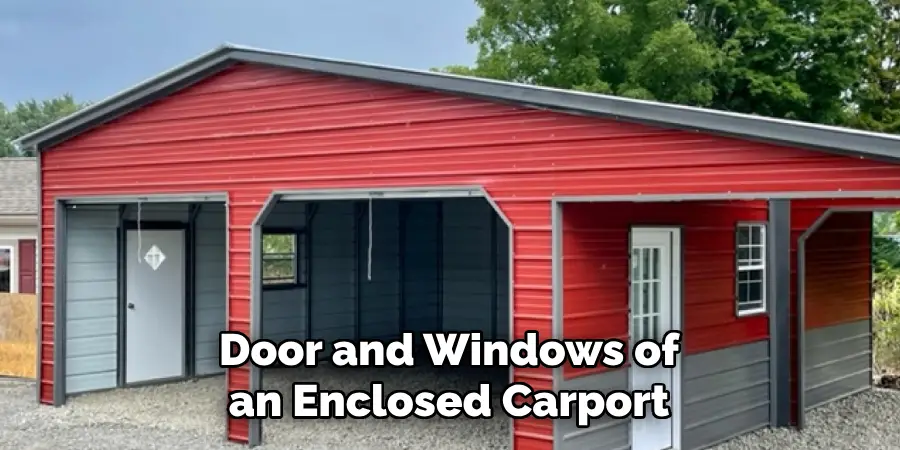
These are just some of the maintenance tasks you should consider after enclosing your carport. Always prioritize safety and promptly address any issues before they escalate into bigger problems. Proper maintenance ensures that your enclosed carport remains functional and visually appealing for years to come.
Can You Enclose Your Own Carport, or Should You Hire a Professional?
If you’re thinking of enclosing your carport, you may be wondering if you can do it yourself or if it’s best to hire a professional. In this article, we’ll explore the advantages and disadvantages of each option.
DIY- Do It Yourself:
Enclosing your carport yourself is definitely an option. If you’re skilled in carpentry or construction, you can handle the project on your own. However, you should consider a few things before taking on this task.
Advantages
- Cost Savings: One of the main advantages of DIY is saving money. You can avoid labor costs and only pay for materials by doing the work yourself.
- Customization: When you enclose your carport yourself, you have complete control over the design and materials used. This allows you to customize it according to your preferences and needs.
- Sense of Accomplishment: Completing a DIY project can give you great accomplishment and increase your self-confidence.
Disadvantages
- Time-consuming: Enclosing a carport is a challenging project and may require several weekends of work. Hiring a professional may be a better option if you’re short on time.
- Lack of Experience: Unless you have experience in construction or carpentry, you may encounter challenges and make mistakes along the way.
- Safety Risks: Working with power tools and heavy materials can pose safety risks if proper precautions are not taken.
Hiring a Professional:
If you need more time, skills, or confidence to enclose your carport yourself, hiring a professional may be the better choice.
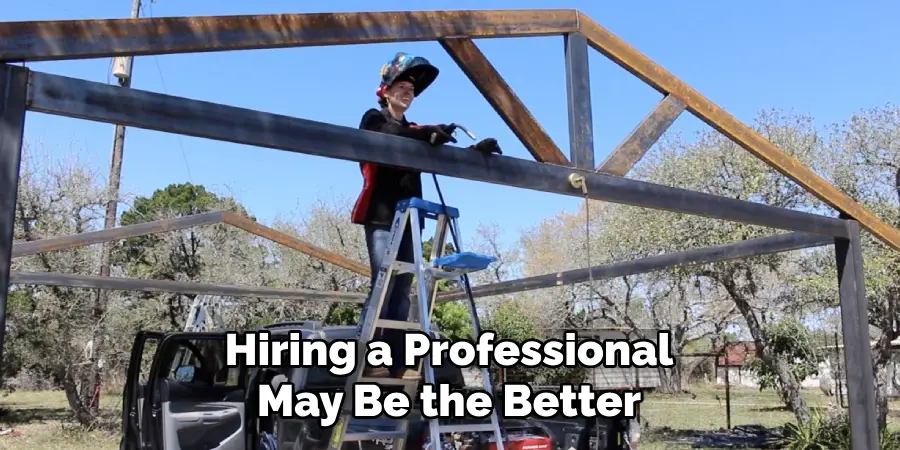
Advantages
- Expertise: Professionals have the necessary knowledge and experience to complete the project efficiently and effectively.
- Time-saving: Hiring a professional eliminates the need for you to spend your weekends working on the project. They can complete the work in a fraction of the time it would take you.
- Quality Work: A professional will have access to better materials and tools, resulting in a higher-quality end product.
Disadvantages
- Higher Cost: Hiring a professional means paying for labor, which can significantly increase the overall cost of enclosing your carport.
- Limited Design Control: While professionals may have some design options, you may have a different level of control over the final product than you would with a DIY project.
- Trusting Others: When hiring a professional, you are entrusting them to do the job correctly and according to your specifications. If any issues arise, rectifying them can be challenging.
Deciding whether to enclose your carport yourself or hire a professional ultimately depends on your skills, availability, and budget. DIY may be a viable option if you have the time, knowledge, and confidence. However, hiring a professional may be the better choice if you’re short on time and want the assurance of quality work.
Are There Any Local Building Codes or Regulations to Consider When Enclosing a Carport?
Yes, checking with your local building codes and regulations before enclosing your carport is important. Each state, city, and county may have specific requirements for enclosed structures, and failing to comply with these codes can result in fines or delays in the project. Some common regulations to consider include:
- Permits: Depending on the size and location of your carport, you may need to obtain a building permit before enclosing it. This ensures that the structure meets safety and zoning requirements.
- Inspections: In addition to obtaining permits, some areas may require inspections throughout the project to ensure it is completed according to the code.
- Weather Conditions: Certain areas may have regulations for enclosed structures regarding high winds, heavy snow loads, or seismic activity. It’s essential to consider these factors when designing and constructing your enclosed carport.
- Safety Features: Building codes often specify safety features such as fire-rated materials, smoke detectors, and proper ventilation in enclosed structures. These regulations protect the structure’s occupants.
It’s crucial to do your research and consult with local authorities before beginning any construction project on your property. Failing to comply with building codes and regulations can result in costly fines or even the demolition of the structure. By following these guidelines, you can ensure that your enclosed carport is functional and legal. Overall, it’s always better to be safe than sorry when it comes to adhering to local building codes and regulations.
Conclusion
In conclusion, many creative and practical ways to enclose a carport exist. Whether you want to add an extra room for storage, create a workshop space, or simply protect your vehicle from the elements, enclosing a carport can be a great solution.
One of the first considerations when deciding how to enclose a carport is determining your budget and timeline. A full renovation with walls, insulation, and electrical work can be costly and time-consuming. Alternatively, you can opt for a more affordable and faster DIY solution using materials such as tarps or screens. Reading this post has helped you learn how to enclose a carport ideas. Make sure the safety precautions are carried out in the order listed.
I am Rick. I grew up helping my dad with his handyman service. I learned a lot from him about how to fix things, and also about how to work hard and take care of business. These days, I’m still into fixing things- only now, I’m doing it for a living.
I’m always looking for new ways to help people grow and develop. That’s why I have created this blog to share all my experience and knowledge so
that I can help people who are interested in DIY repair.

